

The car can be a hostile environment: vibration, bump, shock, extreme thermal excursions, humidity and long life requirements. Aviation and space have long been considered the most hostile environments, and although failure in these fields can have catastrophic effects, component quantities are relatively small and the economics have allowed special attention to design, manufacturing and testing.
The 'humble' motor car on the other hand, requires relatively high quantities, long life and environmental robustness. It also requires commercial-level pricing. Murata has a bookfull of components for automotive applications, all of them meeting these criteria. This article takes a look at some of these.
Airbag systems
The once-simple air-bag has become a sophisticated system of measured reaction to varying conditions. Typical advanced systems will use around six shock sensors. Triggering the right degree of inflation in the right airbags for the right seats, and avoiding spurious operation, needs an extensive range of reliable sensors.
For triggering the system on impact, Murata has a device, in a 6,4 by 2,8 mm footprint (PKGS-00RA) that provides voltage sensitivity of 0,77 mV/g ±15% with non-linearity of 1% and shock resistance of 1500 g. There is an extended low frequency cutoff of ~21 Hz and a typical resonant frequency of 30 kHz. The operating temperature range is -40 to 125°C and the shear mode detection system generates no pyroelectricity.
For detection of seat occupation, child-seat position and distance to the airbag (Figure 1), Murata suggests the MA40 family of ultrasonic sensors operate at a nominal frequency of 40 kHz with a sound pressure level of 103 or 108 dB and minimum sensitivity of -82 to -87 dB. They all have short detection ranges and operate from -30 to 85°C. There are separate or combined transmitters and receivers connected by plug or flying lead. These sensors also perform outside the car, providing weather-proof proximity warning for blind spots and parking in tight spaces.
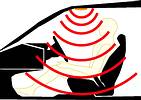
Navigation systems
Satellite navigation systems are great when they can 'see' the satellite, but they need a temporary reference when they cannot. The obvious solution here is our ceramic bimorph gyroscope technology, also employed in video cameras to minimise the effects of camera shake. However, car navigation systems require higher accuracy than other applications. Therefore, Murata has increased the processing accuracy of the bimorph vibrator and devised a new structure that produces more stable vibration.
With the tuning bar piezoelectric gyroscope, the bar is vibrated by piezoelectric ceramics. When rotational motion is applied to the centre axis of the vibrator, a Coriolis force is generated perpendicular to the original direction of vibration. This force is detected by piezoelectric ceramics (Figure 2).
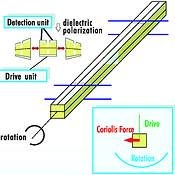
The basic principle used for detection is as follows. Taking the Foucault pendulum (Figure 3), when angular velocity w is applied to the axis where an object of mass m is swinging at velocity V, a Coriolis force expressed by formula F = 2.m.V.w is generated. This force is perpendicular to the reciprocating motion of the pendulum, being largest at the highest velocity point. Generally, the magnitude of angular velocity can be measured by electrically detecting the Coriolis force while keeping V constant.
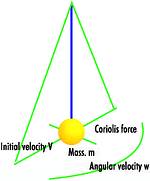
Murata's original structure was triangular, with numerous micron diameter lead-wires making interconnections. This was changed to a rectangular cross-section needing no interconnection, reducing size, improving production efficiency and performance. The latest version is smaller, with a plate inserted into the bottom of the vibrator section providing more stable vibration. Electrical bonding and mechanical support have recently been improved by a new process. (Figures 2 and 4 show the principle of operation.)
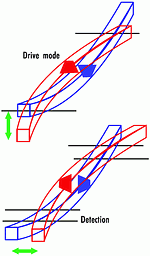
The net result of this work is the ENV-05G, a bimorph gyroscope for car navigation systems. The new design is both much more accurate and easier to produce. In a 12,4 by 7,6 mm package, 18 mm high, it has an operating temperature range of -40 to 85°C, scale factor of 25 mV/deg/s and offset drift of 9 deg/s.
In the engine bay
The engine bay is perhaps the most hostile environment for an electronic component, where temperatures are important, vary widely and must be controlled. The engine is dependent on the temperature of the cooling water for performance as well as survival. It has to be within a relatively narrow band.
At the same time, the engine control unit has to have accurate measurement of intake air temperature. This is essential for optimum performance and for meeting the strict emission limits.
For both tasks, Murata recommends the NTSAO series of NTC thermistors. Unique ceramic technology and automated production provide small, leaded temperature sensors with an operating temperature range of -40 to 125°C. A precise sheet forming method produces resistance and B-constant tolerances of ±1% and a thermal time constant of seven seconds at 25°C. Resistance values range from 2,0 to 100 Ω and B-constants from 3380 to 4250.
Engine knocking can severely damage a power unit before the driver is aware that it is happening. Knock sensors provide feedback to the engine control system to suppress abnormal vibration. High stability resonant and non-resonant piezoelectric elements are mounted directly onto the engine.
The materials used in elements are multicrystal dielectric with a high dielectric constant. They are formed by two processes. First, high temperature firing, after which they have the characteristic crystal structure shown in Figure 5a but do not yet exhibit the properties of piezoelectric material. This is because the electric dipoles within the crystals are randomly oriented and the overall moment of the dipoles is cancelled.

To make ceramics piezoelectric they must be polarised. A DC electric field of several kV/mm is applied to the ceramic to align the internal dipoles in a single orientation (Figure 5b). Due to the strong dielectric properties of the ceramic, the dipole moment remains unchanged after the electric field is removed and the ceramic then exhibits strong piezoelectric properties (Figure 5c).
In the case of knock sensors, emphasis is placed on heat and stress-resistant materials to ensure high performance and long life in the harsh environment under the hood. There are standard designs, but most knock sensors are customer-specific, designed and manufactured to each user's individual requirements.
Intruder alarm sensors
We all know the problem of nuisance car alarms. It derives from the use of IR motion sensors that trigger when they detect movement of a warm body. However, in a closed vehicle in the sun, the air soon warms up and with convection starts moving around. Hence frequent alarms from an untampered parked vehicle.
The solutions to these problems are ultrasonic sensors from Murata. These will not respond to the movement of a body of air, only that of a solid object by detecting the Doppler Shift. This is the MA series.
To give some indication of the possibilities, operating on a nominal frequency of 40 kHz, standard transmitters produce a typical sound pressure level (SPL) of 120 dB and the receivers have a sensitivity of -63 dB. They operate over a range of -30 to 85°C. Resolution is 9 mm and the detectable range is from 0,2 m to 4 or 6 m. Receivers and transmitters sit on 10 mm and 16 mm diameter footprints. Weight and power consumption are negligible and reliability is high.
Rotary position sensors
The modern car has a lot to remember and report, including the settings of the air-conditioning, positions of rear-view mirrors, seats and other items. Position sensors for these tasks must be economically priced and provide long life and repeatability - a million or more operations. Murata is known as a cautious company, only releasing products after extensive testing.
Hence the PVS1 rotary position sensor, for example has a nominal resistance of 10 kΩ ±30% and linearity ±2%. The temperature coefficient of resistance is ±500 ppm/°C with an operating temperature range of -40 to 85°C, operating at 5 V d.c. Dielectric strength is 250 V a.c. and maximum leakage current is 50 µA. Minimum insulation resistance is 100 MΩ at 250 V d.c.
Mechanically, it has a 'D' format through-hole rotor with a low profile and Pb-free terminations. The effective rotational angle is 333 degrees and rotational force is 2 milli-Nm maximum. The advanced three-part design is resistant to soldering heat and allows soldering at the higher temperatures associated with lead-free processing.
Nominal overall dimensions are 14,9 mm by 11 mm including terminations and height is only 2,1 mm. Sensors can be supplied with leads attached. Dust-proof construction, cermet resistive tracks and other materials used enhance stability and contribute to the long working life.
Motor protection
All the functions referred to above require drive motors or actuators of some kind. These, in turn, need protection. Today, traditional fuses are not adequate, either in performance or convenience terms. The positive going thermistor (Posistor) is the ideal replacement for those fuses.
These are produced with differing Curie points, at which the resistance increases rapidly. They respond quickly to excessive current/temperature and self-reset when conditions return to normal. Curve C shows a voltage-current characteristic. (Figure 6).
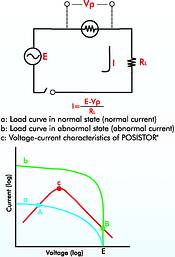
Selection of the correct device is relatively simple. Three characteristics need to be established, applied voltage, normal current and abnormal current. These define the parameters of the protection. Applied voltage should be equal to or less than the maximum thermistor voltage, normal current less than or equal to the Posistor's non-operating current and the abnormal greater than or equal to the operating current.
For automotive applications Murata suggests its six volt series of Posistors, the PTGLS family, radial-leaded on a 5 mm pitch. They offer non-operating currents of 430, 530 and 700 mA and operating currents of 1,4, 1,75 and 2,23 A with a maximum current of 10 A.
Conclusion
Murata makes an extensive range of sensors for motor cars and other automotive vehicles. In addition, customers get more than good products, they get extensive applications support, and all around post design/delivery support that makes designing and producing new products just that bit easier. For designers of today's and tomorrow's automotive systems, Murata can be considered the natural first stop when seeking established and leading-edge components.
| Tel: | +27 12 657 3500 |
| Email: | [email protected] |
| www: | www.communica.co.za |
| Articles: | More information and articles about Communica |

© Technews Publishing (Pty) Ltd | All Rights Reserved